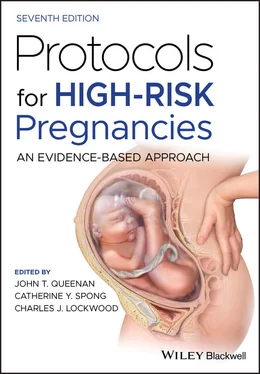The diagnosis of FNAIT is first suspected based upon a qualifying history of a fetus or neonate with suspected or confirmed thrombocytopenia. This presentation can vary widely, ranging from asymptomatic mild thrombocytopenia to spontaneous intracranial hemorrhage (ICH) in the setting of profound thrombocytopenia. The detection of newborn petechiae or ecchymoses in the early hours after birth can be a first sign of thrombocytopenia and should prompt a neonatal platelet count and further investigation if abnormal. ICH is the most severe complication of FNAIT, occurring in about 10–20% of cases. The majority of ICH presentations have a prenatal origin and can result in perinatal death or survival with permanent neurological disability.
A suspected FNAIT diagnosis requires evaluation by parental blood testing, which includes HPA genotyping of both parents. Should a platelet antigen incompatibility be determined within a tested couple, further maternal testing for the presence of antigen‐specific anti‐HPA antibodies is performed to secure a FNAIT diagnosis. Paternal genotyping is also important to determine recurrence risk in a subsequent pregnancy for the same couple, which can be either 50% (paternal heterozygosity) or 100% (paternal homozygosity) for a given disease‐causing HPA antigen, depending on paternal zygosity status. In cases involving paternal heterozygosity, amniocentesis can be performed to determine if the pregnancy is at risk. Chorionic villus sampling (CVS) is discouraged in pregnancies at risk for FNAIT, as it may exacerbate alloimmunization and increase risk for fetal loss. Cell‐free fetal DNA is a promising approach for the noninvasive determination of fetal HPA‐1a status, with limited data supporting clinical accuracy. However, in the United States access to this technology for that indication remains limited, and further validation may be required.
It should be noted that an inability to detect platelet‐specific antibodies does not entirely exclude a FNAIT diagnosis. One example includes cases in which months have elapsed after an affected delivery. For these patients, repeat maternal antibody screening may be considered on an every‐trimester basis in a subsequent at‐risk pregnancy.
Fetal and neonatal alloimmune thrombocytopenia testing is recommended if a patient has an obstetric history diagnostic or suggestive of FNAIT, such as a fetal or neonatal ICH or evidence of neonatal thrombocytopenia <50 000/mL 3, regardless of the presumed etiology. Additionally, testing is advisable if a patient has a biological sister with history diagnostic or suggestive of FNAIT. Universal screening for HPA‐1a antibodies is not believed to be a cost‐effective strategy and is not recommended.
Differential diagnosis involves other conditions that might cause fetal or neonatal thrombocytopenia such as idiopathic thrombocytopenic purpura (ITP), which is also an IgG‐mediated phenomenon causing maternal thrombocytopenia and, occasionally, fetal or neonatal thrombocytopenia. ITP is infrequently associated with minor clinical bleeding in the newborn, and rarely causes fetal or intracranial hemorrhage. ITP clinically differs from FNAIT, as in the latter case the mother herself is usually healthy, with a normal platelet count. Other conditions associated with fetal or neonatal thrombocytopenia include but are not limited to selected maternal‐fetal infections (such as cytomegalovirus or parvovirus), congenital and inherited thrombocytopenias, rare instances of red blood cell antigen alloimmunization, severe ABO incompatibility, and disseminated intravascular coagulation.
Unlike red blood cell antigen alloimmunization, FNAIT can severely affect a first pregnancy. Each successive pregnancy is at risk for fetal thrombocytopenia that tends to be more severe and occur earlier in gestation. A history of fetal ICH is the strongest predictor of an early onset in a future pregnancy. Given that disease worsens with successive pregnancies and that FNAIT‐associated ICH usually occurs prior to labor, antenatal therapy is strongly recommended in all pregnancies complicated by FNAIT in an effort to reduce risk for severe thrombocytopenia and related ICH.
Maternal intravenous human immunoglobulin (IVIG) is the most successful single treatment for the management of FNAIT. While its mechanism is unclear, it is believed to interfere with maternal antibody production and/or transplacental antibody passage. As a standalone intervention, IVIG has been shown to reduce ICH risk when compared to unexposed cases. Maternal side effects include headache, fatigue, flushing, myalgia, nausea, fever and chills, and hypotension. Premedication with acetaminophen and diphenhydramine reduces these ill effects, and in infrequent cases with persistent symptomatology premedication with methylprednisolone may also help. Rarely, IVIG treatment has been associated with aseptic meningitis, acute kidney injury, thrombosis, hemolytic anemia, and stroke. While anaphylactic reactions are believed to be rare, we recommend conducting the initial infusion in a monitored hospital or office setting. Typical dosing is 1 g/kg, administered once or twice weekly depending upon disease severity (see below), with each infusion lasting about 4–5 hours.
While ineffective as a standalone medication, corticosteroids are effective as an adjunct to IVIG for the antenatal treatment of FNAIT. Oral prednisone is recommended in our practice, with doses of 0.5–1 mg/kg daily (see below). Side effects include emotional lability, insomnia, hyperglycemia and gestational diabetes mellitus, acne, hypertension, fluid retention, immunosuppression, and potentially osteoporosis. In addition to glucose challenge test (GCT) screening at a usual gestational age, early GCT screening is recommended for patients exposed to corticosteroids beginning early in gestation. Calcium and vitamin D supplementation is advisable, as well.
Following decades of clinical trials of various approaches for the antenatal treatment of FNAIT, a risk‐based noninvasive approach has been developed that we recommend as a management algorithm. This strategy stratifies patients using clinical history, tailoring treatment regimen intensity based upon past disease severity. Patients are grouped according to whether a prior FNAIT pregnancy was complicated by ICH, and if so, how early in gestation it occurred. While this approach cannot eliminate all risk for severe thrombocytopenia and poor outcomes remain possible, it has proven remarkably successful in a large majority of FNAIT cases.
The risk‐based strata include the following.
This includes women with a prior fetus or newborn with thrombocytopenia or ICH of unproven etiology and evidence of a parental HPA antigen mismatch, but no identification of a specific causative anti‐HPA antibody in maternal serum. As mentioned above, while FNAIT is unlikely in this case, the diagnosis cannot be entirely excluded, especially if maternal FNAIT screening occurred months after the affected index pregnancy. Treatment is not recommended in these cases but repeat maternal antibody screening may be considered on an every‐trimester basis (i.e., at 10–12 weeks, 22–24 weeks, and 30–32 weeks of gestational age) in a subsequent at‐risk pregnancy. Should specific anti‐HPA antibodies be detected, the patient should be triaged to the medium‐risk category and treated accordingly. In cases without parental HPA antigenic mismatch, a rare incompatibility undetectable by conventional screening methods is theoretically possible. In this case, a single antibody screen involving cross‐matching of maternal and paternal platelets at around 20–24 weeks may be considered. With a positive antibody screen for platelet‐specific antibodies, the patient should be escalated to the medium‐risk group, and treatment started.
Читать дальше












